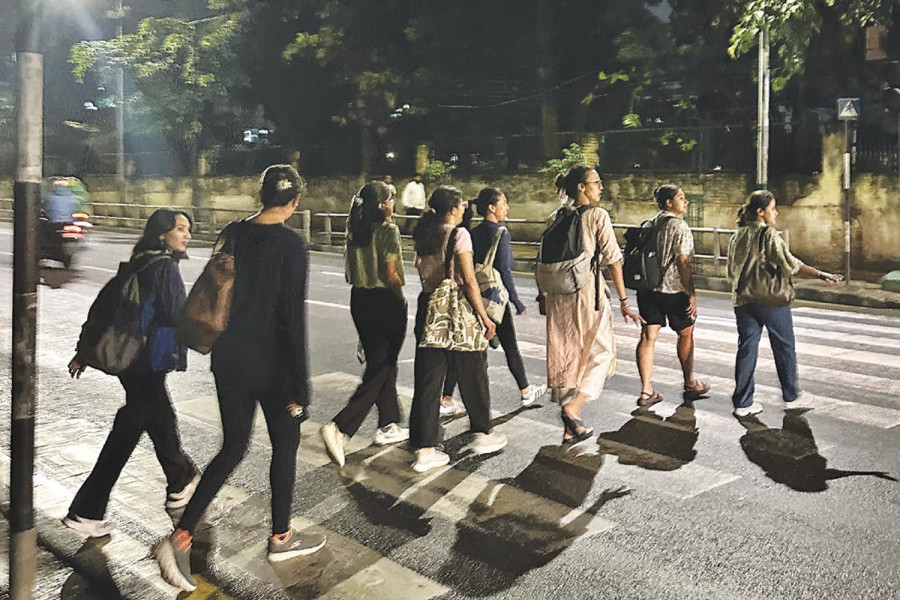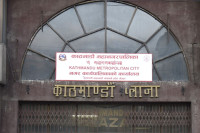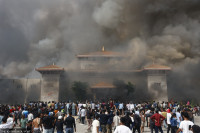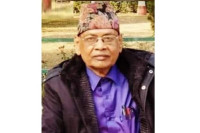Valley
Exploring ‘forbidden’ hours: Women assert access to public space with midnight walks
The group ‘Women Walk at Midnight Kathmandu’ aims to counteract how women’s social lives are often restricted to private spaces.
Ellie Davis
On Friday, July 25, at 10 pm, a group of 21 women went out for a walk in Patan. They didn’t have any destination—they just wanted to walk.
The outing was organised by Women Walk at Midnight Kathmandu and it was the second of two all-women walks that the group has hosted so far—as a form of resistance against mobility restrictions that women face, particularly at night.
“The idea is very simple,” co-leader Samikshya Bhattarai said. “We just want to walk, and we want to walk at night.”
The group’s leaders hope to counteract how women’s social lives are often restricted to private spaces and also encourage women to claim access to the streets of their city at night.
“Public spaces in general are not meant for women,” Bhattarai said. “We never think of women just existing in public spaces—the private sphere has always been the women’s sphere and public spaces have always been the men’s domain.”
The original Women Walk at Midnight gathering was inspired by the anti-rape protests in 2012 in India, in public response to the violent gang rape of a woman referred to as “Nirbhaya,” meaning “fearless”. Having watched Indian classical dancer Maya Rao’s protest performance titled “Walk” during the anti-rape movement, years later, performance artist Mallika Taneja did her own 24-hour walk in New Delhi.
Quickly, though, Taneja realised that the streets of New Delhi were not safe for her to walk alone at night, so she sought strength in numbers, first with both male and female friends who walked alongside her. After this initial walk in 2016, the group decided to make their walk exclusively for women. Ever since then, they’ve been gathering to roam around the city together roughly every month. Today, women have formed chapters of Women Walk at Midnight across India, in Cape Town, and, now, in Kathmandu.
While studying at Jawaharlal Nehru University in India, Bhattarai connected with another student who was a part of the group’s growing South African chapter. When Bhattarai returned to Kathmandu two years ago, she was determined to bring the Women Walk at Midnight movement to her hometown.
With the co-leadership of Bhattarai’s friends Asmita Pandey and Manjeeta Gurung, the group hosted its first group walk on June 20 with 17 attendees, and they plan on continuing to host monthly walks. Each of these young women have their own day jobs—Gurung works in communications, Pandey has a law degree, and Bhattarai is a researcher—but in their free time they’re all committed to improving women’s freedom of movement.
For many women in the group, the walk was the first time that they were seeing their own neighbourhoods in late hours. Being with a large group of other women gave them a sense of safety that they don’t feel when walking alone.
For Gurung, walking at night goes against the instruction she’s always heard from her family to never venture out too late.
“There’s this curfew mentality,” Gurung said. “In my house, you just can’t be at public places when it’s night, so I’d be very anxious about getting back home and not being outside. It’s almost as if I’m committing some crime— I want to change that as well.”
Bhattarai acknowledges that going out at night can at times be dangerous, especially for women. Even in a large group, some women members have experienced catcalling on their walks, but Bhattarai doesn’t think potential danger should stop women from accessing public spaces.
“Sometimes bad things happen,” she said. “But that should not stop every woman from going out, and this should not be a reason for women to not be mobile.”
.JPG)
With their walks, the women aren’t accepting that public spaces at night are too dangerous for them, but instead, consciously working to make such spaces safer with their group presence.
“Everyone uses that language: ‘it’s not safe.’ But why is it not safe?” Bhattarai questioned. “Public spaces will be safer if everyone accesses them, especially people who are usually told they are in danger,” she said, noting that everyone can benefit from safer public spaces.
Though women often don’t go out at night as they’re told it’s not safe, according to Pandey, the pressure to not to do so is not just about safety.
“There is a stigma about going out that’s beyond safety, that when you go outside, you’re being a bad daughter or a bad girl,” she said. “People assume you go out to party, and there’s nothing wrong with that, but the idea of just going out for the sake of going out is nonexistent.”
On their walks, the group leaders often observe how men interact with each other in public spaces in ways that feel impossible to them. During the group’s most recent walk in Patan, when they saw three young men sitting together near Durbar Square playing video games on their phones, they reflected on how none of the women could imagine three girls doing the same.
“I was so surprised,” Bhattarai said. “We live in very different worlds—three boys can decide on a Friday night that they’re just going to hang out at midnight. I would never do this. I’m jealous of them.”
Though the group walks at night, the ways that men and women can access public spaces differ at all hours, the group leaders said. While men can go out to have tea at any point, women more often can only leave their homes for a specific purpose, Bhattarai said.
In addition to leading Women Walk at Night Kathmandu in her free time, Pandey is also conducting research on how female friendships form for the Open Institute for Social Science, an academic research institution in Patan. Her findings confirm that for women, particularly middle-aged married women, it’s rare to connect with friends in public spaces.
“Older women will always need a reason to be with their friends, and there’s no hanging out at all,” Pandey said. “Social life for them is still very much private.”
Though the group has so far consisted mostly of young women from middle to upper-class backgrounds, in the future, Women Walk at Midnight Kathmandu aims to bring together a more diverse group of women from different socio-economic backgrounds and age groups.
After the most recent group walk, having explored their own neighborhoods at what had felt like “forbidden” hours, the group members went home—some in pairs and some on their own—feeling more confident exploring the streets of their city and having made new friendships as well.
“That’s my favorite part about the walk—women just like talking to each other and making friends,” Bhattarai said. “We just want women to have fun.”




 10.12°C Kathmandu
10.12°C Kathmandu









%20(1).jpg&w=300&height=200)

